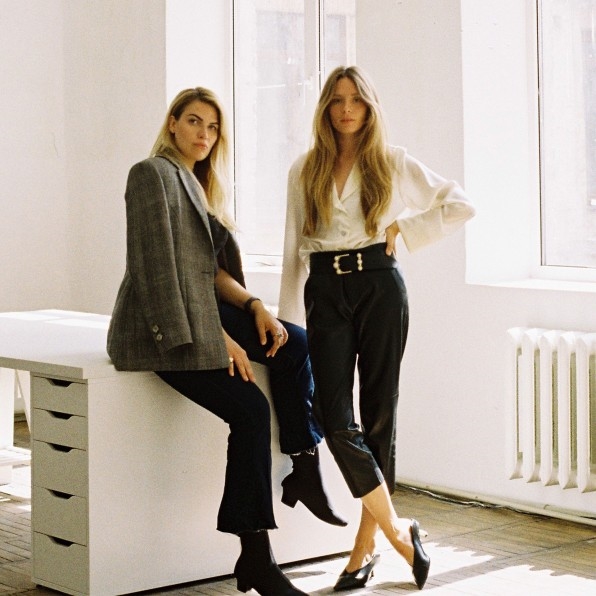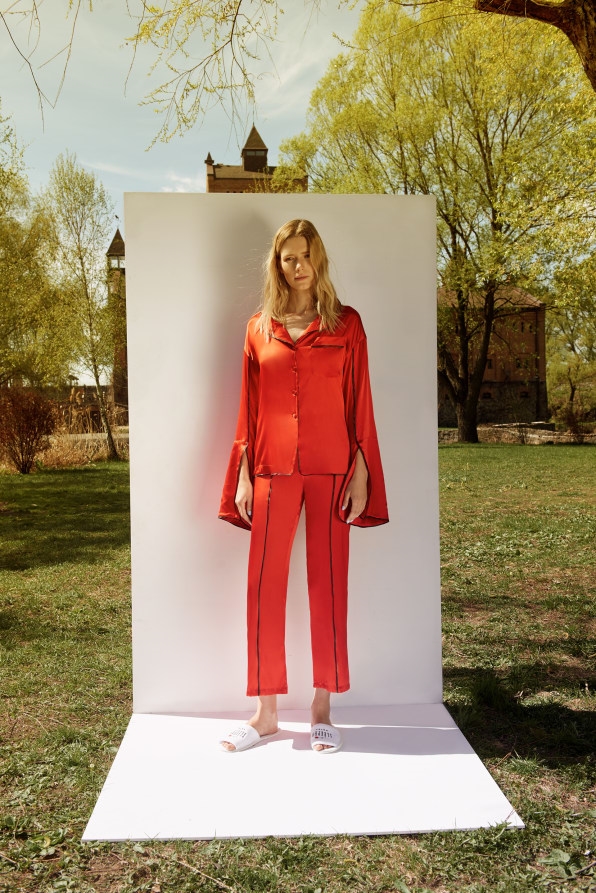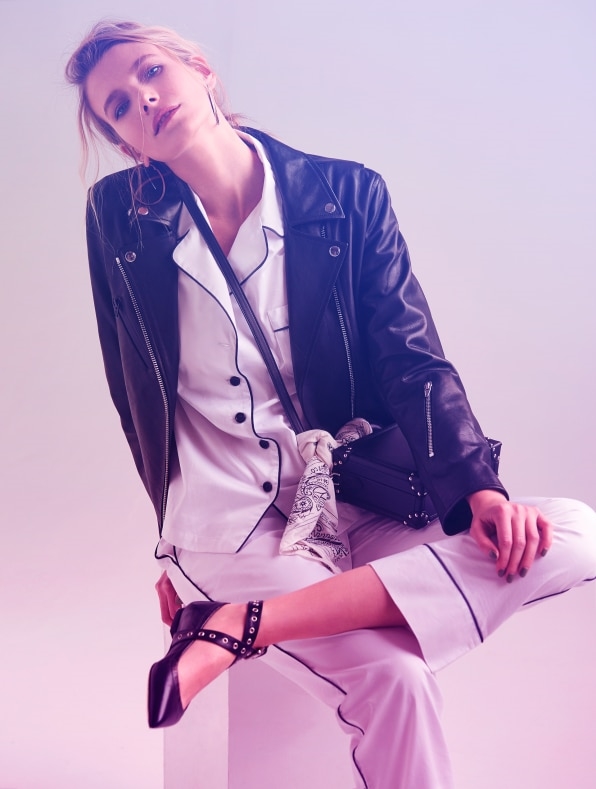Let’s just admit it. There are days when you get up and can’t be bothered to pick out real clothes from your closet so you pull on a sweater over your pajamas and head out for your morning coffee. For some, this is the uniform for a lazy Sunday. For someone like me, who works from home, it might be a sartorial choice for an average Tuesday.
Sleeper, a luxury fashion startup, wants us to stop feeling shame about our everyday-pajama-wearing and just embrace it. “There have always been people who wear pajamas all day,” says Russian-born Sleeper cofounder Asya Veretsa. “They always seem like such happy people. Why shouldn’t everybody wear clothes they feel comfortable and happy in?”

In 2014, Veretsa and her Ukrainian cofounder, Kate Zubarieva, decided to launch a fashionable line of clothes that are specifically designed to be worn from sleep directly into everyday life. Take, for instance, their line of $200 silk slips that look like a nightgown, but throw on some heels and a leather jacket and boom: You’re ready for a date. Wear it with a blazer and boots, and you’re ready for a meeting with your boss. Or take the $220 linen robe, which you can wear around the house on top of your nightie, or as a sundress that looks perfectly respectable for a party or the office, or as a cover-up when you’re at the beach.
Sleeper has quickly gained a following. Celebrities with an edgy, whimsical sensibility have become fans, including Leandra Medin of Man Repeller, actress Emily Ratajkowski, singer Rita Ora, and fashion entrepreneur Mira Duma. Last summer Marie Claire declared Sleeper’s linen, off-the-shoulder dress the “best garment of the year.” And retailers ranging from Harrods and Moda Oparandi to Opening Ceremony and Barneys want to carry Sleeper garments on their shelves.

[Photo: courtesy of Sleeper]
Of course, it hasn’t escaped Varetsa that launching a high-end pajama-as-everyday-clothing brand is a slightly crazy idea. She explains that it took guts to start Sleeper. Back in early 2014, Varetsa wanted to launch her own business. She decided to head from Russia to Kiev, Ukraine, to start Sleeper with her friend (and now cofounder) Zubarieva, but as she arrived at the train station in her new city, violent anti-government protests had erupted in the streets. Over the next few days, 82 people would be killed, and more than a thousand injured.
Over the next few months, a full-fledged revolution had taken over the Ukraine, plunging the country into political instability. The economy was destabilized, unemployment skyrocketed, and young people in particular couldn’t find jobs. But in the midst of this madness, Varetsa and Zubarieva, who were both in their early twenties at the time, felt empowered to launch a business. “In that context, you become fearless,” Varetsa explains. “You feel like you have nothing to lose. So many people our age were unemployed, so it felt good to be doing something for ourselves.”
They only had $2,000 to spend on launching Sleeper, so the pair searched for a tailor to make a couple of pajamas, Varetsa herself built the website, and they got talented friends of theirs to shoot models wearing the outfits. They reached out to fashion journalists, and within weeks, Franca Sozzani, the editor-in-chief of Vogue Italia named Sleeper the brand of the month. This put Sleeper on the map. Other glossy magazines quickly took notice and top-notch department stores started asking about carrying their products in store.

Over the next few months, Varetsa and Zubarieva decided to focus on refining their supply chain to meet this demand. To ensure quality control, they moved into their own workshop and hired a team of seamstresses with decades worth of experience. Each garment takes between eight and 12 hours to sew by hand. And the company only uses natural, eco-friendly fibers like organic linen and silk.
The founders set up offices across the glass wall, so both the business development and manufacturing employees would feel like they were part of the same team. The team is now 20-people strong. But Varetsa has just moved to New York, since 80% of Sleeper’s sales now come from the U.S. market. Revenues have been growing steadily: last year, the brand says that it grew by 150%.
Sleeper has been part of a broader trend in fashion, as designers have pulled from traditional sleepwear in their collections. Back in 2015, the runway was full of pajama-clad models, with brands from Gucci and Alexander McQueen to Diane von Furstenberg embracing the trend. By 2016, the look had trickled into celebrities, with Kim Kardashian, Rihanna, and Selena Gomez wearing pajamas on the red carpet. Sleeper’s founders believe that the sleepwear as everyday wear trend has trickled into the mainstream. And they believe it’s here to stay. “We’re seeing that Americans increasingly want to be comfortable in what they wear everyday,” Veretsa says.
Related: These Companies Dream Of Becoming The Lululemon Of The Pajama Industry
She’s got a point. We’ve seen American fashion become increasingly more relaxed. Back in the 60s, most men still wore suits every day and many women wouldn’t leave the house without a proper dress, hat, and handbag. But over the last few decades, thanks, in part, to Silicon Valley’s startup culture, many workplaces have encouraged employees to dress comfortably for work. Instead of shift dresses or blazers, people started wearing jeans and hoodies. Then came athleisure, the trend of wearing yoga pants and running tights out of the gym and into everyday life. So why not take it a step further and wear sleepwear into the office? “It’s definitely where fashion seems to be going,” says Varetsa.
However, this isn’t to say that you will necessarily wear the same outfit to work that you wore to sleep in. Over the last four years running Sleeper, Varetsa says that many people often buy these pajamas and robes specifically to wear out, and they don’t necessarily sleep in them. “When people talk about sleepwear, they are often really just talking about loungewear,” Varetsa. “These clothes generate an emotional response. They make people think about being cozy and happy, and they want to wear them to outside of the bedroom.”

[Photo: courtesy of Sleeper]
In fact, speaking with customers, she’s noticed that many people own plenty of elegant pajamas that they don’t go to bed in. They wear these outfits when they want to relax at home before bed wearing a face-mask or reading a book on a weekend because they represent a glamorous kind of relaxation. The goal of Sleeper is to make these frivolous pieces of clothing slightly more functional by allowing people to wear them in new contexts, Varetsa explains. “We’ve all been influenced by the same Hollywood movies where women are lounging around in beautiful pajamas,” Varetsa says. “Wearing these pieces puts us in a cozy, optimistic frame of mind. Why shouldn’t we wear things that make us happy everyday? “
Fast Company , Read Full Story
(20)